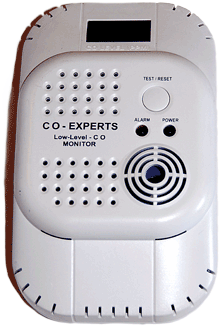HOW MY CO DETECTOR ACHIEVED VIP STATUS
Here is a story about a flight I made a few years ago. If you read it you will understand why I am a strong advocate of always carrying a good CO detector in your flight bag. This flight took place a nice December day in 2005. The airplane was a rental but in very good shape and almost brand new. The purpose of the flight was to practice commercial maneuvers, that is, steep descending turns, Chandelles and Lazy Eights. None of this got done due to a high level of CO in the cockpit.
I never did find out the reason for the high CO levels. This doesn't matter as the CO detector shows what is going on then and there and tells you, the pilot, that something needs to be done to remedy the situation. I wrote the story just two days after it happened, with everything fresh in mind.
I should add that I'm not in any way related to Aeromedix, apart from buying my CO detector from them. There are many good detectors out there, of many different brands. The important thing is that you get yourself one, if you don't already own one.
December 16 2005
Last Friday I went up by myself with an Archer III, taking off from BWI. As always I carried my over-sized and over-stuffed flight bag with me. Among the myriad of things in it is a CO detector bought from AeroMedix. I've been dragging it around on every flight I've done for over one year, but it has never showed any signs of life, except when I suspiciously press the self-test button to see if it really works. On this occasion this little gadget would save the day.
 As I was crossing the Chesapeake Bay, coming in over Kent Island,
the CO detector started to sound an alarm; four beeps (loudness
at 85dB) every sixth second. The detector has different types
of alarms for different levels of CO. This was the ultimate
alarm for high levels of CO. At first, however, I wasn't sure
what the alarm was and where it was coming from (ANR headsets
can have their drawbacks). I soon glanced at the CO detector,
which was placed in the back-seat. I could see something in the
display (which is usually completely blank), and read '05PPM'. "Well" I thought "5 ppm isn't too bad, why is the alarm sounding
and why is it alarming for HI levels?". I leaned over a little
more and saw that it was actually reading '105PPM'. Now this kind
of CO level is bad for your health, so I immediately turned off
the heater and defroster and opened the little side window. My
options were to land at Bay Bridge airport, which was just behind
me, continue to Easton or return to BWI. Although 105 ppm of CO
is high, it wouldn't incapacitate me immediately, so I opted
for BWI. I contacted Potomac approach (still within the ADIZ) and asked
for clearance back to BWI. I was immediately given clearance
back into Bravo airspace and they asked if I needed any assistance.
I explained the CO situation and declined assistance except that
I needed to get back to BWI asap. In retrospect, I could have
declared a PAN-PAN situation, which would have achieved the same
result, but with fewer words (and shown how savvy I was with ATC
lingo). Alas, I didn't think of that until afterwards.
As I was crossing the Chesapeake Bay, coming in over Kent Island,
the CO detector started to sound an alarm; four beeps (loudness
at 85dB) every sixth second. The detector has different types
of alarms for different levels of CO. This was the ultimate
alarm for high levels of CO. At first, however, I wasn't sure
what the alarm was and where it was coming from (ANR headsets
can have their drawbacks). I soon glanced at the CO detector,
which was placed in the back-seat. I could see something in the
display (which is usually completely blank), and read '05PPM'. "Well" I thought "5 ppm isn't too bad, why is the alarm sounding
and why is it alarming for HI levels?". I leaned over a little
more and saw that it was actually reading '105PPM'. Now this kind
of CO level is bad for your health, so I immediately turned off
the heater and defroster and opened the little side window. My
options were to land at Bay Bridge airport, which was just behind
me, continue to Easton or return to BWI. Although 105 ppm of CO
is high, it wouldn't incapacitate me immediately, so I opted
for BWI. I contacted Potomac approach (still within the ADIZ) and asked
for clearance back to BWI. I was immediately given clearance
back into Bravo airspace and they asked if I needed any assistance.
I explained the CO situation and declined assistance except that
I needed to get back to BWI asap. In retrospect, I could have
declared a PAN-PAN situation, which would have achieved the same
result, but with fewer words (and shown how savvy I was with ATC
lingo). Alas, I didn't think of that until afterwards.
I got the Archer turned around, plugged in Direct KBWI in the GPS and engaged the autopilot. If I got woozy, at least I'd be pointing in the right direction and keep the shiny side up. I glanced back at the CO detector and now it was reading '125PPM', and this without heater/defroster and with the side window open. "Not good" I thought. So I stuck my hand out through the window to scoop fresh air into the cabin. This well-known Piper-trick works fine on the ground while taxiing on a hot summer day. It works in cruise as well, except that the slipstream almost tears your hand off. Another aspect is that it was cold, actually very very cold. Nevertheless, I kept my hand in the slipstream, bent over and tried to breath the air coming through the window rather than the CO-rich cabin air. The main problem now was that I couldn't hear anything from ATC as the wind was making a racket. Especially when I bent towards the window and the wind hit my microphone. So I alternated between closing the window briefly, listening if ATC was screaming at me, and keeping the window open and my hand as an air-scoop. Well, nobody was screaming at me, but ATC was directing traffic around me. This procedure seemed to work; With the hand-scooping I got the CO reading down to 65PPM. As soon as I closed the window it went up towards 100PPM again.
Eventually I was cleared to land on runway 33R, descended, got
my flaps out, closed the window and landed. It was actually a
pretty decent landing. The only problem was that when I closed
the window for the last time, I had lost all feelings in my right
hand (I had alternated between using my left and right hand to scoop).
I actually thought that I'd break off the fingers if I'd hit the
hand  on something. In the end I had to maneuver the flaps,
throttle and mixture with my wrist. Finally I arrived at the
parking, shut down, opened the door and took a deep breath.
I think I unconsciously minimized my breathing from short final
(when I closed the window) until the Archer was parked.
on something. In the end I had to maneuver the flaps,
throttle and mixture with my wrist. Finally I arrived at the
parking, shut down, opened the door and took a deep breath.
I think I unconsciously minimized my breathing from short final
(when I closed the window) until the Archer was parked.
In the end this was a non-event, thanks to the warning from the CO detector. Without it, things may have ended differently. Apart from the incessant beeping from the detector, there was nothing with the airplane that hinted at the possibility of high CO levels. I probably would have started maneuvering while my physiological 'density altitude' would have been climbing and my performance descending. Not a good combination while doing steep spirals, lazy eights and chandelles.
So what went wrong and what went right in this situation? The reason for the CO leak is still unclear. The muffler system is of course the prime suspect. Time will tell. Did I make the right decision to head back to BWI? In retrospect, I'd say it would have been better to have landed at Bay Bridge airport and assessed the situation from there. Turning off the heater and defroster is a standard action. In addition I could have leaned the engine more aggressively. This would decrease the amount of CO in the exhaust gas and hence the amount of CO entering the cabin. I'll do that next time. Flying with one hand in the slipstream for a prolonged period effectively makes you one-handed when it comes to critical maneuvering, such as landing. Not good, especially if a go-around would have been called for. But it worked in keeping the CO level below 'critical'.
From now on I'll carry my over-sized, over-stuffed and way-too-heavy flight bag without complaining...and my Aeromedix CO detector will get a special VIP corner compartment inside the bag.
